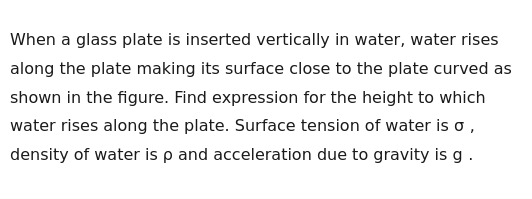Question
Question: When a glass plate is inserted vertically in water, water rises along the plate making its surface c...
When a glass plate is inserted vertically in water, water rises along the plate making its surface close to the plate curved as shown in the figure. Find expression for the height to which water rises along the plate. Surface tension of water is σ, density of water is ρ and acceleration due to gravity is g.

h = √((2σ cosθ)/(ρg))
Solution
Explanation:
-
Laplace Pressure: The pressure jump across a curved liquid–air interface is given by
ΔP = σ/𝑅,
where σ is the surface tension and R is the radius of curvature (only one radius is effective since the curvature in the direction parallel to the plate is zero). -
Hydrostatic Pressure: The pressure difference from the free surface to a point along the plate where the water has risen height h is
ΔP = ρgh. -
Geometry of the Meniscus: For a meniscus that is approximately a circular arc meeting the plate with contact angle θ, one can show (using simple geometric relations) that
R = h⁄(2cosθ). -
Equating Pressures: Equate the hydrostatic and Laplace pressures:
ρgh = σ/R = 2σcosθ/h. -
Solve for h:
Multiply both sides by h:
ρg h² = 2σ cosθ
Then,
h² = (2σ cosθ)/(ρg) → h = √((2σ cosθ)/(ρg)).
Answer:
h=ρg2σcosθ.
Additional Information:
- Subject: Physics
- Chapter: Surface Tension (as per NCERT Class XI)
- Topic: Capillarity
- Difficulty Level: Easy
- Question Type: descriptive
This derivation is appropriate for a 12th grade student with a basic understanding of capillary phenomena and surface tension.
